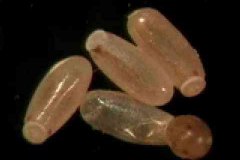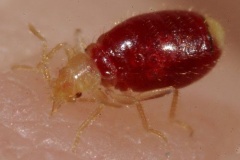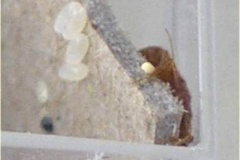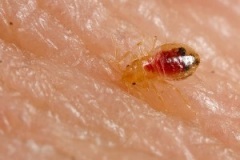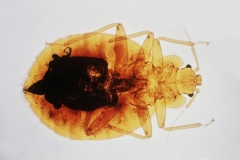If you are one of the thousands of people who are unlucky enough to have to deal with an outbreak of bed bugs, dont be in despair. Although it may be difficult to eliminate bed bugs completely, it is not impossible. In fact, before reaching for strong chemical pesticides, try some home remedies to get rid of bed bugs.
In this article, we will explore:
Extermination of bed bugs requires comprehensive controls. Before starting the treatments, you need to prepare the area to make sure bed bugs dont have many places to hide.
Contrary to popular beliefs, bed bugs do not just hide in your bed, but also anywhere near your bed, including your clothes, cardboard boxes and cracks in the wall. If you have a lot of clutter in your home, it just means more places for bed bugs to hide. That means you will have a harder time locating the pests and killing them. Therefore, start by throwing all your dirty clothes in the laundry, taking out all clutter from beneath the bed and, if possible, patching up cracks in the walls and floors.
Throw your dirty clothes, bedding, mattress, pillowcases, stuffed toys and any other things that can be washed in hot water into the washer. Make the water very hot; bed bugs cannot survive in hot temperatures, and the water will also drown them. Colored fabrics that cannot be washed in hot temperatures should be tumble-dried on hot settings.
There are a lot of clothes and stuff that cannot be washed in hot temperatures. For those, you can use a steam cleaner. A steam cleaner on high heat is quite effective in getting rid of bed bugs as neither the biting insects nor their eggs can stand temperatures above 140 degrees Fahrenheit. The great thing about steam cleaners is that the steam comes out with some pressure, allowing it to penetrate deep into the bedding, sofa cushions, and cracks and crevices. Make sure that you use dry steam rather than wet steam as the moisture may ruin the fabric and wooden surfaces.
Vacuuming, in and around the infested area, is extremely important. Take your vacuum cleaner up to your mattress and vacuum it to suck out the bed bugs and their eggs from their hiding places. Vacuum under and around the bed, on the walls, particularly the place where the wall meets the floor, over cracks and crevices, in your closet and on all upholstered surfaces. If your room has a carpet, vacuum it thoroughly as well, as bed bugs often lay their eggs on the edges. Once you are done vacuuming, through away the vacuum bag away from your home, as it may contain live bugs or their eggs.
Encase your mattress, pillows, box springs and comforters in tight encasements made of tough fabric, which do not allow bed bugs to get to your skin. Sealing up your bedding means any bed bugs left inside will not be able to get out and gain access to you. This means that they will eventually starve to death. Depending on the temperature, bed bugs can go without a bloodmeal for 20 to 400 days, so keep your bedding encased for at least a year.
A lot of bed bugs often make their homes in your bed. Therefore, move your bed away from the walls, bed stand, or other furniture that your bed may be touching so that the pests do not crawl onto them and start spreading. Do not let your blankets dangle on to the floor; otherwise, bed bugs will be able to climb up and down from it. For added protection, place bed bug interceptors underneath each foot of the bed so that they trap any bug trying to make its way into or out of the bed.
Before you start looking for a professional exterminator, here are a few natural bed bug home remedies that you should consider first.
The fossilized remains of microalgae, diatomaceous earth is proven to kill 90% of a bed bug infestation. The great thing about it is that it is chemical free. The substance is an abrasive potent desiccant and kills bed bugs by splitting their exoskeleton and dehydrating them from the inside.
To use, apply 100% diatomaceous earth on areas where you suspect bed bug activities. If you have pets and small children, opt for food-grade diatomaceous earth. Although the substance may take over a week to kill bed bugs, it has quite a hard mortality rate. Since its marketed as a fine powder, you can inject it inside cracks and crevices as well that are not easy to get into.
Even though food-grade diatomaceous earth is non-toxic and can even be eaten theoretically, we advise you not to do so. Do not inhale it, as it is extremely drying and is composed of tiny crystals that can damage your lungs.
After a few weeks, vacuum up the powder, reapply it and repeat for a few weeks until all the bed bugs are gone.
Like diatomaceous earth, silica gel is also made of silicon and is a dehydrating agent. However, it is not abrasive but has an amorphous and porous form. You may have noticed tiny packets marked as desiccant inside shoe boxes and some food products that contain silica gel. To use them to treat bed bugs, grind the silica gel beads into a fine powder and spread them around areas which have bed bugs. However, like diatomaceous earth, you need to be careful, as inhalation of silica gel can be harmful.
Soda bicarbonate is used to rise or cakes at home, but it also has another great use: eradicating bed bugs. Baking soda works by sucking out the moisture and oil shield from the insects chitin and ultimately killing the bed bugs. Sprinkle a light layer of baking soda in affected areas. After one week has passed, vacuum the area and re-sprinkle it. It may take you weeks to eliminate bed bugs with baking soda, and you will need large quantities of it as the remedy will need to be repeated, so the cost may be slightly prohibitive. Still, it is a very safe and fairly effective way to get rid of these pests.
A salt of boric acid, this substance is a very effective cleaner due to its antibacterial properties. Borax is also used to clean out eyes as well as get rid of bed bugs. The substance works by destroying the bed bugs digestive system after they eat it. However, since bed bugs prefer bloodmeal over any other type of food, it is almost impossible for them to eat it. However, it can be used as a deterrent. Apply a liberal amount of Borax on the seams and the bed of the legs. You can also dissolve it in water and spray the solution on these places. Even if it doesnt kill the bed bugs, it will prevent them from going where the powder is.
Similar to bed bug interceptors, double-sided tapes can trap bed bugs making their way to and from the bed. Apply the tapes around or beneath the legs of your bed and other furniture so that any crawling insect ends up getting stuck on the adhesive. Keep your sheet, blankets, and bedding from touching the ground as a few bed bugs may crawl over to reach your bedding.
Another popular bed bug home remedy option is to use rubbing alcohol. Pour some alcohol into a spray bottle and spray it all around the affected area. Rubbing alcohol is a solvent and can dissolve the protective layer of chitin on bed bug shells, effectively drying them out on contact.
There are several home remedies for bed bugs with vinegar. Vinegar is a strong-smelling acid and can be used to kill and repel bed bugs. It is also used in cooking, so most of us usually have a bottle of it in our home, make it one of the most convenient bed bug killing home remedy. Vinegar kills these pests by damaging their nervous system; however, it cannot destroy the eggs.
To treat bed bugs with vinegar, saturate the edges of your bedding and furniture with the distilled white vinegar and spray directly on bed bugs. That way, if the pests try to flee, they will be met with a parameter of vinegar, which wont let them cross.
Tea tree oil is a potent antibacterial, antiseptic, antifungal and antiviral essential oil. Tea tree oil not just prevents and treats pathogen-related infections but is also a great remedy for destroying small infestations of bed bugs and preventing re-infestation. It also works as a wonderful cleaning agent and helps in masking human smells that attract bed bugs. It is also quite inexpensive.
To eliminate a minor outbreak, dilute about 20 drops of pure tea tree oil into 200ml of water and spray onto places where you have observed bed bug activity, including your bedding, sofas, furniture, curtains, and cabinets. The oil works by suffocating the bed bugs. In its undiluted form, it is naturally more effective; however, it may then not be safe to use around pets and children as it is quite potent.
You can use a blend of cayenne pepper, ginger, and oregano to create a bed bug fighting spray right at home. The hot spiciness of the ginger and pepper, as well as the potent smell of oregano oil, are an effective repellant against bed bugs.
To make it, take one part cayenne pepper, one part ginger, one part oregano essential oil and one part water and bring the mixture to boil for about 7 minutes. Strain the solution, put it in a spray bottle and spritz it around areas with bug activities. You may need to repeat the process a few times until all bed bugs are gone.
The oils in peppermint leaves serve as an effective bed bug repellant. Crush a cup of dry mint leaves and then sprinkle the shreds into corners where bed bugs have been seen. If the infestation is wide-spread, you may need more than one cup. You may have to repeat the process. To do that, simply vacuum up the old peppermint leaves and replace them with new ones, until all the bed bugs have disappeared.
Using lavender oil is one of the best home remedies for bed bug sprays. Although lavender instills calmness and relaxation, it is also a great way to repel and kill bed bugs. In fact, lavender oil has been reported to be sued for centuries to protect clothes and linens from insects like moths and silverfish.
Black walnut tea is a natural bed bug home remedy. Like tea tree oil, it has antifungal, antibacterial and insecticidal properties. It is also a great herbal tree. All you need to do is to take used black walnut tea bags and place them in affected areas, in cracks and crevices, mattresses, beddings and furniture, to get rid of the insects and their eggs.
You can also sprinkle the dried tea leaves in infested areas rather than use tea bags. Alternatively, you can make a herbal sachet by mixing three parts black walnut tea, 3 parts thyme, 2 parts sweet flag, 1 part lavender, and 1 part mint. The aroma of the mixture will help in repelling bed bugs.
This tall plant grows on the edges of rivers, lake, marshes, and wetlands. You can also find a herbal mixture in packets from the market. This herb has microbial properties and an aroma, combined which can be effective repealing bed bugs and other insects. You can make a solution of the sweet flag and spray it on affected area as a natural remedy for bed bugs.
This is a traditional Balkan method to trap insects. Take some bean leaves and spread them on the surfaces where there is bed bug activity. The leaves have microscopic hooked hair which can entangle bed bug legs and impale them. Create a barrier with these bean leaves; bed bugs will either be repelled or those foolish enough to walk into the trap, will be killed.
The leaves of the Indian lilac have a repelling effect like other plant-based remedies. Crush the leaves and spread them around the affected area. Alternatively, you can boil the leaves and put the strained solution in your bath water to prevent bed bugs from snacking on you. You can also spray Indian lilac oil around your bedding and furniture to get rid of bed bugs.
Burning thyme near the infested areas can help get rid of bed bugs, though it may take a few days. Thyme has insecticidal properties and can be used in a variety of ways to fight off bed bugs. You can also take fresh thyme leaves and place them around your bed and furniture in net bags to keep away insects. Replace with fresh thyme every three days.
Lemongrass essential oil actually kills bed bugs rather than just repelling them. The high acidity in lemongrass can kill the bed bugs and their eggs and also serve as a repellant. It doubles as a room freshener because of its tangy, citrusy smell.
Beauveria Bassiana is a parasitic fungus which likes to feed on insects like bed bugs. When the microscopic seeds come in contact with insects bodies, they penetrate the cuticle and grow inside the shell. The insect soon becomes immobile, unable to feed and infertile. It also dies within three to five days.
A derivative of the brightly-colored chrysanthemum flower, this substance produces refined pyrethrins, a natural insect killer that throws bed bugs nervous system into overdrive, paralyzes them and kills them. This substance is extremely effective against bed bugs; however, some strains have developed resistant to pyrethrins. To circumvent this issue, it is suggested that pyrethrums and pyrethrins be used in conjunction with other natural products like silica gel and diatomaceous earth, which enhances effectiveness.
Although bed bugs are not known to spread any fatal diseases, their bites can be very irritating and may lead to secondary infections. If you have itchy and red bites on your body, wash the area with soap and water and use the following home remedies:
Applying an ice pack to a bed bug bite can help relieve swelling and itchiness. Apply some ice cubes wrapped in a thin towel to the bite for 10 minutes. You can reapply the ice pack throughout the day.
Since baking soda is alkaline, it can help neutralize the acid in bed bug bites. Make a thick paste of baking soda by adding water to it and apply on the affected area to reduce swelling and pain.
Cinnamon has analgesic, antibacterial and inflammatory properties that make it a great natural remedy for bed bug bites. Ground the spice with some water and apply it to the bite; this will seal the area, preventing infection and healing the inflammation. Repeat throughout the day.
Using calamine lotion is one of the best home remedies for bed bug bites. The lotion has a cooling effect on the bite, acts as a skin protector, reduces inflammation and alleviates pain. The main active ingredient is zinc oxide which is used to treat several types of rashes, including mosquito bites and chicken pox.
Raw apple cider vinegar is a potent antimicrobial, which you can apply to bed bug bites. This will prevent infection, get rid of redness and pain and promote healing.
Toothpaste contains menthol which is an astringent and cooling agent. Placing some toothpaste on bed bug bites can almost instantaneously relive you of itchiness and bring down redness and swelling. In fact, it is used to soothe burns in Asian countries.
Witch hazel also has anti-inflammatory and astringent properties which can soothe irritated skin caused by bed bug bites. It is also believed to treat varicose veins without surgery.
If your bites turn into blisters, feel tender, ooze discharge or exhibit symptoms of an allergic reaction, you should see a dermatologist for treatment.
Aloe vera gel has medicinal soothing and antiseptic properties that make it one of the best natural home remedies for bed bug bites. Take an aloe vera leaf, remove the spines on its side and split it down length-wise to take the top and bottom layer apart. Scoop out the aloe vera gel and place it on the bite.
A: Bed bug bites are red and inflamed in the form of welts. You may see a darker spot in the middle from where the bed bug has fed. The welts are usually in a straight or zigzag line, often on the parts of the body which makes contact with the bed.
A: Severe allergic reactions, like anaphylactic shock, from bed bug bites are extremely rare, although people who have been bitten by the bug often report of hives, itchy welts and itchy bumps which may increase risks of infection when scratched. These welts may persist for weeks, but this is quite common.
A: Yes, they all work, though some may perform better than the others. Some bed bugs home remedies are effective in killing these insects while others just repel them. The effectiveness of home remedies also depends on the size of the infestation.
A: Although all bed bug home remedies are fairly effective, they work best when combined with each other. For example, you can sprinkle diatomaceous earth or Borax on affected areas to kill biting adults. You can soak yourself in an Indian lilac bath to prevent the remaining bugs from biting you. To prevent re-infestation, you can place thyme, sweet flag and black walnut tea sachets around your bed and cracks and crevices.
A: One of the best home remedies to get rid of bed bugs is to use heat, either by laundering fabric in hot water or using a steamer or blow-dryer. You can also sprinkle diatomaceous earth or silica gel on the mattress that can dry out the eggs. You can then vacuum them up and throw the vacuum bag away from the house.
A: Unfortunately, no. Bed bugs are very resilient and can come back any time they sense your sleeping place is not well-protected. To be on the safe side, repeat the application of home remedies every few weeks. Also keep your furniture, bed, floors, and walls well-vacuumed and place natural repellants in these areas to keep these pests away.
Visit link:
19 Best Home Remedies For Getting Rid of Bed Bugs

 Residence
Residence  Location
Location 

